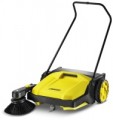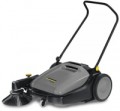Performance
The performance of a cleaning machine is the area that the unit can process in an hour.
Usually, the specs indicate the maximum performance achieved under perfect conditions. It may turn out to be somewhat lower due to the specs of the room, the presence of old dirt and other factors. However, the theoretical difference is usually quite consistent with the actual one. For example, models for 1000 m2/h and 2000 m2/h will differ in performance approximately by two times. So, according to this parameter, it is quite possible to evaluate different models and compare them with each other.
Note that high performance requires a powerful motor and capacious tanks, which affects the dimensions, weight and cost of the unit. Therefore, excessive performance is just as undesirable as insufficient. In addition, more powerful machines usually have a larger working width and are not well suited for rooms with an abundance of narrow passages and nooks and crannies.
As for the actual values, models
less than 1000 m2/h belong to the entry-level. It is the specs that most household machines have (see "Type"). A value
from 1000 to 2000 m2/h is relatively low for professional sweepers and the average for scrubber dryers.
2000 – 3000 m2/h is considered a fairly solid performance, and models of
more than 3000 m2/h is extremely ra
...re. These are mostly high-end sweepers (it is extremely difficult to achieve such characteristics in scrubbers).Working width
The width of the space that a harvester can cover in one pass. In models with removable side brushes (see above), this paragraph indicates figures only for the unit itself, and the width of the grip with brushes is specified separately (see below).
The large working width is convenient when working in large open spaces - it allows you to complete the job in fewer passes. In turn, machines with a small working width - and, accordingly, a relatively narrow body - are more passable, they are better suited for environments with a large number of hard-to-reach places. So you should choose based on this parameter taking into account the characteristics of the premises/territories being served.
Waste tank
The volume of the garbage tank provided in the design of the harvester. The garbage tank is equipped with sweeper and suction sweeper units (see above). The larger the capacity of this container, the more garbage it can hold and the less often it will have to be emptied. On the other hand, this indicator can significantly affect the weight and dimensions of the sweeper, despite the fact that for small volumes of cleaning (for example, occasional sweeping of the path at the exit from the garage), a capacious garbage tank is simply not required. Therefore, manufacturers usually choose the capacity of this tank based on the general class of the harvester and the work for which it is designed.
Weight
The total weight of the cleaning machine. Usually, weight is indicated with empty tanks for detergent, waste, fuel, etc. At the same time, additional equipment, such as side brushes, may or may not be taken into account. Such equipment has a very small weight compared to the machines themselves. And, when installed/removed, does not seriously affect the mass of the entire machine.

